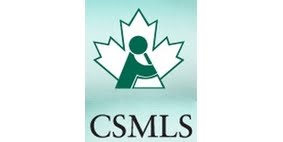I've had a tremendous amount of fun working with, and learning about the moulds posted here. However, all things do come to an end as does this blog, and so I will leave this last one with you as a challenge. Have some of your own "fun with microbiology" and let me know what you think the name of this mould should be.
It appeared as a plate contaminant on an un-inoculated plate of laboratory media. While I took numerous photos, I did not follow through sufficiently to determining an identification.
Macroscopic Morphology:
-exhibited rapid growth on Sabouraud Dextrose Agar at 30oC
-the isolate developed a short, 'fuzzy' surface
-colour was a grey-brown to a dark brown with a lighter coloured outer fringe
-the reverse was dark brown
-I did not test the growth at 37oC or above so this remains unknown.
Unidentified mould - after 7 days on Sabouraud Dextrose Agar (SAB or SDA) at 30oC (Nikon)
Microscopic Morphology:
-isolate developed septate, branched hyphae
-conidia developed directly from the hyphae (sessile) or from short stalks that appeared somewhat 'inflated' where the attached to/supported the conidium
-these conidia (?) were rather large, up to 10 µm in diameter. Some appeared intercalary and perhaps were chlamydospores (?)
-spiral hyphae were occasionally observed
Unidentified mould - a first look at the edge of a slide culture does not reveal much detail.
Unidentified mould - at a slightly higher magnification conidia closely attached to the parent hyphae are evident. (250X, LPCB, DMD-108)
Unidentified mould - younger, immature conidia retain the lactophenol cotton blue (LPCB) stain while the maturing conidia begin to develop a dark pigment.
(400X, LPCB, DMD-108)
Unidentified mould - immature conidia (blue) & maturing (dark) conidia occur in about equal numbers in this photo.
(400X, LPCB, DMD-108)
Unidentified mould - darkly pigmented sessile conidia seen along the hyphae. Some
younger (blue staining) conidia still seen closer to the ends of the hyphae.
Unidentified
mould - as above
(400X, LPCB, DMD-108)
Unidentified
mould - large numbers of conidia produced.
(400X, LPCB, DMD-108)
Unidentified
mould -as above
(400X, LPCB, DMD-108)
Unidentified
mould -sympodial growth pattern (arrow) ? Further explanation follows further below.
Unidentified
mould -a round conidium attached to the hypha by a short stalk, wider at the conidium than at the hypha. (1000X, LPCB, DMD-108)
Unidentified
mould -large, immature conidia attached to hyphae
(1000X, LPCB, DMD-108)
Unidentified
mould - rather large conidia measuring up to 10 µm in diameter. Note the base still attached to the one free conidium. (1000X, LPCB, DMD-108)
Unidentified
mould -spiral hyphae were regularly seen.
Unidentified
mould -conidia at different stages of maturity. Note the attachment of the dark conidium near center left of the photo. It appears to still be attached by its inflated base or stalk.
(1000X, LPCB, DMD-108)
Unidentified
mould - not a good photo -Why did I include this?
(1000X, LPCB, DMD-108)
Unidentified
mould - two conidia attatched to or growing within? the hypha
(1000X, LPCB, DMD-108)
Unidentified
mould -septate, branching hyphae with terminal and sessile conidia.
(1000X, LPCB, DMD-108)
Unidentified
mould -large terminal oval conidium (chlamydospore?) seen in center of photo. Immediately behind it there is a branch with a basal septum supporting a slightly out of focus conidium. (1000X, LPCB, DMD-108)
Unidentified
mould - just left of center, is what appears to be an intercalary conidium (chlamydospore). That is, it appears to be in the middle of, and continuous with the hypha and not attached to it. (1000X. LPCB, DMD-108)
Unidentified
mould -conidia attached directly to the hyphae (sessile), on short, somewhat inflated stalks, and one near center-right on a longer simple stalk (or branch?) Septations in the hyphae clearly visible. (1000X, LPCB, DMD-108)
Unidentified
mould -another photo as above. A couple of the conidia appear to have a concave dimple. Curious. (1000X, LPCB, DMD-108)
Unidentified
mould -and because 'more is better', here is another photo showing different stages of maturity and attachment. (1000X, LPCB, DMD-108)
Unidentified
mould -septate hyphae with sessile conidia.
(1000X, LPCB, DMD-108)
Unidentified
mould - growth pattern of hyphae suggests sympodial growth (see next slide). Pigment or stain may be exuded by the hyphae. (1000X, LPCB, DMD-108)
Growth pattern of Sympodial vs Monopodial
Unidentified
mould -Sessile conidium - resting right on the hypha.
Unidentified
mould -you may remember this photo from earlier in this post, however, here is a closer look at the central dark conidium and the short inflated base attaching it to the broken hypha. A younger, ellipsoidal conidium appears in the lower left. Note too the rather thick-walled appearance of the round conidium in the upper left.
(1000+10X, LPCB, DMD-108)
Unidentified
mould
(1000+10X, LPCB, DMD-108)
Unidentified
mould -a photo showing many of the features mentioned previously. Conidia (chlamydospores) appear to be intercalary, withing the hypha. Suggestions of sympodial growth pattern. Large ellipsoidal terminal conidium appears to have a septum (arrow), dividing it into two compartments. (1000X, LPCB, DMD-108)
* * *































.jpg)
.jpg)
.jpg)















.jpg)























